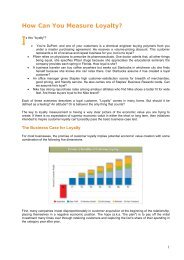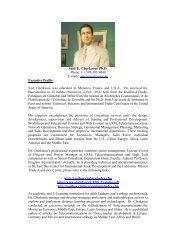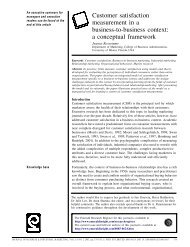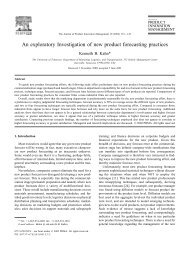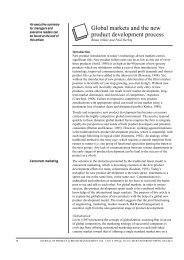The Executive's Guide to Branding
The Executive's Guide to Branding
The Executive's Guide to Branding
You also want an ePaper? Increase the reach of your titles
YUMPU automatically turns print PDFs into web optimized ePapers that Google loves.
<strong>The</strong> Executive’s <strong>Guide</strong><br />
<strong>to</strong> <strong>Branding</strong><br />
Corporate Performance and Brands:<br />
<strong>The</strong> Risk and Return Effects of <strong>Branding</strong><br />
Institute Perspectives<br />
Zyman Institute of<br />
Brand Science
<strong>The</strong> Executive’s <strong>Guide</strong> <strong>to</strong> <strong>Branding</strong><br />
Everything must have a value proposition. This is<br />
especially true for evaluating the use of business practices,<br />
such as branding. What exactly is the value proposition of<br />
branding? What are the benefits of branding? How does branding<br />
affect risk and return in corporate performance? Let’s explore this<br />
<strong>to</strong>pic with the <strong>to</strong>p 10 burning questions about branding.<br />
This manuscript is based on a seminal article titled “Market-based Assets and<br />
Shareholder Value: A Framework for Analysis” published in the Journal of<br />
Marketing by Rajendra Srivastava (Executive Direc<strong>to</strong>r, Zyman Institute of Brand<br />
Science), Tassaduq Shervani and Liam Fahey in January 1998. This article received<br />
the Maynard and Paul Root/MSI Awards for contributions <strong>to</strong> both the theory and<br />
practice of marketing—the only manuscript <strong>to</strong> receive both awards simultaneously.<br />
Interested readers are referred <strong>to</strong> the original article for greater details.<br />
<strong>The</strong> <strong>to</strong>p 10 questions executives want <strong>to</strong> know:<br />
10. What are brands anyway?<br />
9. Why bother with branding?<br />
8. Do strong brands lower cus<strong>to</strong>mer churn?<br />
7. Do strong brands manage cus<strong>to</strong>mer selection?<br />
6. Do strong brands engender greater loyalty when the purchase<br />
decision is perceived as high risk?<br />
5. Do strong brands lead <strong>to</strong> lower information costs in the purchase<br />
process?<br />
4. Do strong brands result in “imperfect” markets and provide their<br />
owners monopolistic powers?<br />
3. Do strong brands increase the liquidity of a firm’s s<strong>to</strong>ck?<br />
2. Do strong brands reduce risk associated with future cash flows?<br />
1. Do strong brands result in growth and acceleration of cash flows?<br />
Zyman Institute of Brand Science – Perspectives 2
10. What are brands anyway?<br />
What is the origin of branding? <strong>The</strong> word brand is derived from Old English<br />
meaning “burning stick” (and ultimately from the Indo-European word<br />
meaning “<strong>to</strong> be hot”). Lives<strong>to</strong>ck branding was used by the ancient Egyptians<br />
as early as 2700 BC as a theft deterrent, as s<strong>to</strong>len animals could then be<br />
readily identifiable.<br />
Egyptians ‘Branded’<br />
Around the 10 th century merchant marks, formed from simple linear designs,<br />
increased in usage. <strong>The</strong>se marks were known as the ‘signa meca<strong>to</strong>rium’ in<br />
Roman-Dutch law. Merchant marks were used <strong>to</strong> prove ownership of goods<br />
that were missing due <strong>to</strong> shipwrecks, pirates, or other mishaps. <strong>The</strong>y were<br />
also useful for the tracking of goods by people who were illiterate.<br />
<strong>The</strong> first recorded brands in the Western Hemisphere were the Three Latin<br />
Crosses of Hernán Cortéz, who landed in Mexico in 1519. Additionally, brands<br />
are easily recognized patterns that are used for identification purposes.<br />
Lives<strong>to</strong>ck being driven across an open range necessitate an easy method of<br />
identification <strong>to</strong> prevent ownership disputes when the animals were<br />
commingled with other s<strong>to</strong>ck. Brands were subsequently used in the<br />
American west as a promise on part of a seller <strong>to</strong> “make good” on defective<br />
lives<strong>to</strong>ck sold <strong>to</strong> buyers.<br />
Craftsmen in Europe and Japan formed guilds that affixed “production marks”<br />
<strong>to</strong> their products. <strong>The</strong>se marks were used as a method <strong>to</strong> insure quality, as<br />
defective goods could be traced back <strong>to</strong> its origin. <strong>The</strong>se marks allowed the<br />
guild warden <strong>to</strong> fine or expel a craftsman from the guild for faulty<br />
craftsmanship. Whereas this guild mark was a personal mark the industrial<br />
revolution fostered the growth of commerce and the brand mark became a<br />
more generalized legal instrument.<br />
As trade grew consumers were less likely <strong>to</strong> deal directly with the artesian<br />
that made the crafts. Special laws were enacted that were related <strong>to</strong> forgery,<br />
counterfeiting and fraud laws. Courts in France, England, Germany and the<br />
US prevented the “passing off” by a third party as being genuine goods of<br />
the trademark holder.<br />
Zyman Institute of Brand Science – Perspectives 3
Today, brands are still protected by trademark. In the US, according <strong>to</strong> the<br />
1946 trademark law, commonly called the Lanham Act, the fundamental<br />
purpose of the trademark is identified as a measure “<strong>to</strong> protect the public<br />
from deceit, foster fair competition, and…<strong>to</strong> secure <strong>to</strong> the business<br />
community the advantage of reputation and good will.” In essence brand is<br />
used by an organization <strong>to</strong> identify and distinguish goods sold or<br />
manufactured from one individual from that from another.<br />
9. Why bother with branding?<br />
From the consumer viewpoint, the brand is a signal of quality. <strong>The</strong>y trust<br />
manufacturers <strong>to</strong> stand behind their brands. <strong>The</strong>ir positive experience with<br />
brands helps establish both a preference for the brand as well as an<br />
emotional attachment. In essence, brands reduce risk. For consumers, there<br />
are many potential risks involved in a purchase. <strong>The</strong>se include:<br />
Functional risk: will the product perform <strong>to</strong> expectations?<br />
Physical risk: does the product pose a threat <strong>to</strong> the health?<br />
Financial risk: is the product worth the price?<br />
Social risk: will the product result in embarrassment?<br />
Time risk: will there be associated opportunity costs with a<br />
product failure?<br />
A strong brand authenticates the source of the goods, and also promises the<br />
value of goods sold. By providing a promise of value the consumer is assured<br />
in the purchase decision process that the risk-<strong>to</strong>-reward ratio of purchasing a<br />
strong brand is higher than that of purchasing a similar unbranded good.<br />
Why does this matter?<br />
While the brand promise reduces risk for buyers, it creates an uneven playing<br />
field among competi<strong>to</strong>rs vying for their business. Owners of well-regarded<br />
brands enjoy an advantage relative <strong>to</strong> competition. That is, consumer<br />
preference and loyalty for brands enable pricing flexibility and, on the margin,<br />
monopolistic powers.<br />
<strong>The</strong>re is a trickle down effect for the business. Strong brands lead <strong>to</strong> lower<br />
risks (e.g., lower vulnerability and volatility of revenues and cash flow) and<br />
higher returns (i.e., higher levels of profits due <strong>to</strong> the ability of dominant<br />
brands <strong>to</strong> extract price premiums, command larger market shares, or<br />
negotiate lower distribution costs with retailers) for shareholders. Brands,<br />
much like investments in manufacturing infrastructure, are therefore<br />
business assets. Yet they have greater advantages than standard<br />
manufacturing equipment since brands are legally protected and therefore<br />
shielded by an isolation mechanism that prevents diffusion throughout the<br />
industry. In that respect brands are relatively valuable, rare, imperfectly<br />
imitable, and non-substitutable. By that definition brands enable their owners<br />
Zyman Institute of Brand Science – Perspectives 4
<strong>to</strong> enjoy sustainable competitive advantages—and therefore superior<br />
financial performance.<br />
8. Do strong brands lower cus<strong>to</strong>mer churn?<br />
<strong>The</strong> cus<strong>to</strong>mer churn rate (or its inverse the cus<strong>to</strong>mer retention rate) is an<br />
important metric used in marketing. It is estimated that the cost of acquiring<br />
cus<strong>to</strong>mers is at least five times greater than that of cus<strong>to</strong>mer retention. It<br />
doesn’t take a rocket scientist <strong>to</strong> figure out that selling <strong>to</strong> a stable cus<strong>to</strong>mer<br />
base (low churn) is more profitable than selling <strong>to</strong> a cus<strong>to</strong>mer base with a<br />
high-turnover rate (high churn). Does strong branding help reduce cus<strong>to</strong>mer<br />
churn? Cus<strong>to</strong>mer loyalty is a function of switching costs, differentiation, and<br />
brand preference. <strong>Branding</strong> takes the core benefits of a product and extends<br />
them in<strong>to</strong> a source of greater value through the accretion of intangible<br />
benefits (like lower perceived risk and added emotional benefits). By adding<br />
these additional benefits the brand earns a higher degree of differentiation.<br />
And relevantly differentiated brands lead <strong>to</strong> lower cus<strong>to</strong>mer churn.<br />
Zyman Institute of Brand Science – Perspectives 5
7. Do strong brands manage cus<strong>to</strong>mer selection?<br />
Selecting the right cus<strong>to</strong>mers leads <strong>to</strong> lower performance risk for a business.<br />
<strong>The</strong> best cus<strong>to</strong>mers <strong>to</strong> target include those that exhibit the greatest returns<br />
for the business, either in a lower cost <strong>to</strong> serve, greater revenue capture, or<br />
both. Strong brands have both a retention component and an attractant<br />
component. A brand well positioned on the price/performance matrix helps<br />
potential cus<strong>to</strong>mers self-select based on desired segmentation. A strong<br />
brand can convey specific user imagery that speaks <strong>to</strong> the target market.<br />
And once the cus<strong>to</strong>mer self-selects they become familiar with the brand.<br />
<strong>The</strong>ir positive experience with the brand reinforces their trust in<br />
complimentary offers from the brand’s owners.<br />
Thus, by acquiring the ‘right’ cus<strong>to</strong>mers one can decrease the volatility of<br />
earnings because the cus<strong>to</strong>mer base will exhibit lower churn, and the<br />
cus<strong>to</strong>mer self-select process lowers the costs of cus<strong>to</strong>mer acquisition for<br />
complimentary products. Strong family brands help introduce a cus<strong>to</strong>mer <strong>to</strong><br />
related products within and across product lines, which in the long run<br />
supports a lower cost of doing business. Cus<strong>to</strong>mers introduced <strong>to</strong> a family<br />
brand are strong candidates for cross-selling and solutions selling. Since<br />
cus<strong>to</strong>mer acquisition cost is lowered by using brand extensions <strong>to</strong> launch<br />
related products, the profit of the business across product lines is enhanced.<br />
For example, a cus<strong>to</strong>mer already familiar with Microsoft Word is more likely<br />
<strong>to</strong> try Microsoft Excel when the need for a spreadsheet arises.<br />
6. Do strong brands engender greater loyalty when the purchase<br />
decision is perceived as high risk?<br />
Some purchases are more risky than others. <strong>The</strong> risk associated with<br />
purchasing a candy bar is lower than that of purchasing a mutual fund. <strong>The</strong>re<br />
simply is more <strong>to</strong> lose in the latter. <strong>The</strong> higher the risk the more important<br />
the brand becomes in the purchase criterion. For “search” goods, one can<br />
evaluate the qualities of the product before the purchase. Many consumer<br />
packaged goods fall in<strong>to</strong> this category. <strong>The</strong> risk associated with the purchase<br />
is quite low since the quality can be examined before the purchase, or tried<br />
at a low cost. As the goods become more intangible it becomes harder <strong>to</strong><br />
discern the quality of the offer and that makes the brand more prominent.<br />
For experiential or credence goods, product quality is often difficult <strong>to</strong> discern<br />
even after consumption, and you might need extensive experience before<br />
arriving at such an assessment. After all, you do not drive a car for a week<br />
and become convinced of its overall reliability!<br />
In such cases, the consumer’s brand perceptions of intangibles such as<br />
implied reliability, quality and image of product innovation and expertise play<br />
a critical role in determining cus<strong>to</strong>mer loyalty. Experience with a brand<br />
Zyman Institute of Brand Science – Perspectives 6
lowers perceived risk and enhances loyalty. Lack of experience with a<br />
product leads <strong>to</strong> higher risk perceptions reducing the likelihood of that option<br />
being tried by consumers. Thus, in “experience” goods consumer often rely<br />
on the sellers’ expertise. In this case the sellers brand associations lead the<br />
consumer’s choice.<br />
Interestingly, while brand management practices are common in the<br />
consumer packaged goods industries, they can be expected <strong>to</strong> be even more<br />
valuable in product markets where experience and reliance on brand<br />
associations are even more critical in reducing risk and influencing choice.<br />
Thus firms offering high-risk “experiential” goods and firms in services<br />
industries should find branding very attractive. Service offerings (like finance,<br />
real estate, insurance, travel) and technology-based offers are great<br />
candidates for benefiting from superior brand management practices. For<br />
technology-based industries the rate of innovation is high and subsequently<br />
this makes the rate of uncertainty in the purchase decision high (such as risk<br />
of functional performance). And, that in essence makes branding<br />
fundamentally vital.<br />
5. Do strong brands lead <strong>to</strong> lower information costs in the purchase<br />
process?<br />
Lower information costs in the purchase process results in lower perceived<br />
risk. One approach <strong>to</strong> measuring brand equity is <strong>to</strong> decompose it in<strong>to</strong> two<br />
components: (1) a liking/emotional component, and (2) an information cost<br />
component. Because costs associated with making a choice among<br />
competing options include search and evaluation costs, strong brands that<br />
are more familiar and that have positive associations (e.g., quality) that are<br />
Zyman Institute of Brand Science – Perspectives 7
important in the purchase situation effectively lower information costs for<br />
prospects. <strong>The</strong> lower information costs reduce perceived risk, and result in<br />
enhanced purchase likelihood and, therefore, enhanced market share.<br />
4. Do strong brands result in “imperfect” markets and provide their<br />
owners monopolistic powers?<br />
<strong>The</strong> two extreme forms of market structure are monopoly and perfect<br />
competition. Perfect competition is characterized by many sellers, each<br />
selling similar products. In perfect competition there are few barriers <strong>to</strong><br />
market entry, and prices reach equilibrium. Producers in perfect markets are<br />
price takers. Prices are set by the market and the seller has no leverage.<br />
Price elasticity is high and that means a small increase in price will be met<br />
with a large decrease in demand. In a perfectly competitive market the low<br />
cost producer wins.<br />
Unfortunately, as most economics textbooks will demonstrate, the optimal<br />
price under perfect competition is characterized by the condition “marginal<br />
revenue = marginal cost”. Thus, under perfect competition profit margins are<br />
at a level that is less than desirable.<br />
<strong>The</strong> central role of marketing strategy is <strong>to</strong> make markets imperfect. Here<br />
brands play an important role. Brands are differentia<strong>to</strong>rs. Brand loyalty (or<br />
cus<strong>to</strong>mer retention) is evidence that cus<strong>to</strong>mer preferences are not<br />
determined by the lowest price. Brands, by influencing consumer preferences,<br />
Zyman Institute of Brand Science – Perspectives 8
make markets imperfect. <strong>The</strong>y reduce price competition, and doing so lower<br />
price elasticity. And, as provided by the protection of trademark law, a brand<br />
is a legal mini-monopoly. Brand management is therefore a legally protected<br />
method of making markets imperfect.<br />
3. Do strong brands increase the liquidity of a firm’s s<strong>to</strong>ck?<br />
Liquidity risk is a concern for inves<strong>to</strong>rs. Liquidity refers <strong>to</strong> the ability <strong>to</strong> get<br />
in<strong>to</strong> and out of an investment. A liquid s<strong>to</strong>ck is one that is easy <strong>to</strong> buy and<br />
sell. <strong>The</strong> liquidity is closely linked with the bid-ask spread and the volume<br />
sold. Bids are the buyers’ acceptable price, and asks are the sellers’<br />
acceptable price. <strong>The</strong> bid and ask must meet for a transaction <strong>to</strong> occur.<br />
Consistently large bid-ask spreads imply low liquidity, while small bid-ask<br />
spreads imply high liquidity. Part of the bid-ask equation is about supply,<br />
while the other half is about demand. Firms with strong brands are<br />
associated with higher awareness levels. That high awareness not only helps<br />
support sales of the firm’s goods, but also creates awareness of the firm as<br />
an investment, thus increasing the demand for the s<strong>to</strong>ck. Broader ownership<br />
of s<strong>to</strong>ck enhances liquidity and thus enables a firm with strong brands <strong>to</strong><br />
convert assets in<strong>to</strong> cash.<br />
Additionally, brand equity is like a latent asset or a “cash reserve” for a firm.<br />
When facing a near term cash shortage a firm can pare back on its marketing<br />
communication expenses. <strong>The</strong> decay rate of sales and market share for<br />
strong brands during the periods that their marketing communications<br />
Zyman Institute of Brand Science – Perspectives 9
support is reduced (or even eliminated) can be quite slow. This allows the<br />
firm <strong>to</strong> increase its short-term cash flow, but not indefinitely. Brand equity<br />
will decay over time without reinvestment, but the short term sustain rate<br />
provides flexibility that helps smooth variances in cash flows.<br />
For some brands the reservoir of brand equity remains for years after the<br />
brand looses marketing support, or even after the brand is taken off the<br />
market. Black & Decker’s DeWALT brand was one such brand that was<br />
rejuvenated after its withdrawal from the market. Often unused brand names<br />
can be sold as they provide access <strong>to</strong> valuable cus<strong>to</strong>mers. <strong>The</strong> venerable<br />
German brand “Singer” (of sewing machines fame) was sold for several<br />
million dollars as it was recognized globally and had a worldwide distribution<br />
network that could be leveraged <strong>to</strong> sell household products.<br />
2. Do strong brands reduce risk associated with future cash flows?<br />
In general, investments expected returns are estimated on the fundamental<br />
risk of the investment vehicle. If one reduces a risk associated with future<br />
cash flows (as exhibited by the volatility and vulnerability of cash flows) of an<br />
investment the cost of capital is reduced. Volatility is defined as any<br />
occurrence that creates fluctuations in cash flow. Vulnerability is simply as<br />
any occurrence that negatively affects cash flow.<br />
Strong brands reduce the volatility of revenues by relevantly differentiating<br />
the offers of the firm, thereby enhancing loyalty. Enhanced loyalty lowers the<br />
long-term investments associated with maintaining a cus<strong>to</strong>mer base.<br />
Zyman Institute of Brand Science – Perspectives 10
Enhanced loyalty also reduces the volatility of cash-flow as the cus<strong>to</strong>mer<br />
base is less likely <strong>to</strong> switch, keeping demand more stable.<br />
While brand loyalty is expected <strong>to</strong> result in lower volatility and vulnerability<br />
of cash flows and therefore corporate risk, can this be also be expected <strong>to</strong><br />
reduce the cost of capital?<br />
<strong>The</strong> firm’s <strong>to</strong>tal cost of capital is expressed as the WACC (Weighted Average<br />
Cost of Capital). <strong>The</strong> WACC combines the cost of debt with the cost of equity.<br />
Both components can be expected <strong>to</strong> decrease with a reduction in business<br />
risk associated with the firm’s operations. Several fac<strong>to</strong>rs suggest that<br />
companies with strong brands will face lower business risk. Persistence of<br />
lower business risk should lead <strong>to</strong> lower cost of capital. Contributing fac<strong>to</strong>rs<br />
include:<br />
Demand variability - the more stable, the lower the business risk.<br />
Sales price variability - the less variable the lower the business risk.<br />
Input price variability - the less variable the lower the business risk.<br />
Market pricing power – elasticity of demand – higher brand loyalty<br />
implies lower price elasticity and therefore lower business risk<br />
<strong>The</strong>refore, lowering the risk in the firms’ cash flows reduces the cost of<br />
capital <strong>to</strong> the firm.<br />
Some recent findings suggest that trust and lower perceived risk associated<br />
with branded products may carry over in<strong>to</strong> securities. That is, consumers<br />
who have a positive ownership experience with GE appliances just might<br />
think that the General Electric Company is a good (higher return, lower risk)<br />
bet. This suggests that, ceteris paribus (all other things being equal), for<br />
firms with better corporate reputations, inves<strong>to</strong>rs should be willing <strong>to</strong> accept:<br />
Higher financial risk (Beta) for same return<br />
Lower return for same Beta<br />
Either of these will reduce the cost of capital and therefore increase market<br />
capitalization. Using the Fortune Corporate Reputation Index as a measure of<br />
corporate brand equity, recent studies have shown that the cost of capital<br />
difference between the “best” and “worst” reputation firms can be as much<br />
as 0.5 percent, depending on the industry.<br />
1. Do strong brands result in growth and acceleration of cash flows?<br />
A dollar in the pocket <strong>to</strong>day is better than one a year from now. Earlier cash<br />
flows are preferred because risk and time adjustments reduce the value of<br />
later cash flows. Strong brands lead <strong>to</strong> cash flow acceleration due <strong>to</strong> more<br />
rapid market penetration (enhanced diffusion of innovation). Strong brands<br />
improve market penetration because brands reduce the perceived risk for the<br />
Zyman Institute of Brand Science – Perspectives 11
cus<strong>to</strong>mer. When the brand is a trusted source there will be a faster new<br />
product trial rate, higher referral rate, and faster time-<strong>to</strong>-adoption.<br />
For example, in high tech (hardware and software) industries tier-one brands<br />
exhibit a faster rate of diffusion than tier-two or tier-three brands. Strong<br />
brands also provide additional risk reduction by promoting faster market<br />
penetration. Brands with strong brand and channel power have the luxury of<br />
being able <strong>to</strong> enter markets late without hindrance <strong>to</strong> subsequent market<br />
dominance. This allows the firm <strong>to</strong> reduce risk by letting other industry<br />
participants bear the risk of market experimentation. Firms like Microsoft,<br />
Proc<strong>to</strong>r and Gamble, and Coca-Cola use market scanning ‘radar’ <strong>to</strong> seek new<br />
opportunities. Microsoft was not the first <strong>to</strong> launch a word processor,<br />
spreadsheet, presentation application, personal information manager, media<br />
player, graphic operating system and the like. Yet it currently dominates the<br />
market for these applications.<br />
About the Authors<br />
Rajendra Srivastava is widely recognized as a thought leader in performance<br />
based marketing. He is the Executive Direc<strong>to</strong>r of the Zyman Institute of Brand<br />
Science, and Professor of Marketing at Emory University’s Goizueta Business<br />
School. Contact him at raj@zibs.com.<br />
Greg Thomas is Direc<strong>to</strong>r of Programs at the Institute. His experience is firmly<br />
grounded in driving business results based on innovation in marketing<br />
management. Contact him at greg@zibs.com.<br />
Zyman Institute of Brand Science – Perspectives 12
Bibliography<br />
“His<strong>to</strong>rical Trademarks: In Use Since . . . 4,000 B.C.” Brian J. Winterfeldt, Dow,<br />
Lohnes & Albertson, PLLC, Washing<strong>to</strong>n, DC, USA, INTA Bulletin Archive: March 2002<br />
Elson Kaseke, “Trade Marks: Fundamental Elements of the New Law,” Registrar,<br />
Belize Intellectual Property Office.<br />
Jimmy Dun, “Cattle, the Most Useful Animal of Ancient Egypt,” Accessed 09-21-2004.<br />
http://www.<strong>to</strong>uregypt.net/features<strong>to</strong>ries/cattle.htm<br />
J. Thomas McCarthy “McCarthy On Trademarks And Unfair Competition” (4th ed.<br />
2001); Clark Boardman Callaghan, 1992.<br />
Per Mollerup. Marks of Excellence: <strong>The</strong> His<strong>to</strong>ry and Taxonomy of Trademarks.<br />
Phaidon Press, 1999.<br />
Rajendra Srivastava, Tassaduq Shervani and Liam Fahey “Market-based Assets and<br />
Shareholder Value: A Framework for Analysis” Journal of Marketing, January 1998.<br />
Zyman Institute of Brand Science – Perspectives 13
Contacts:<br />
For further information, please visit www.zibs.com or contact:<br />
Zyman Institute of Brand Science<br />
Goizueta Business School<br />
Emory University<br />
1300 Clif<strong>to</strong>n Road<br />
Atlanta, Georgia 30322 USA<br />
Main: +1 (404) 727-9172<br />
Web: www.zibs.com<br />
Academic Facing Contacts<br />
Sundar Bhradwaj<br />
Direc<strong>to</strong>r of Academia<br />
Professor of Marketing<br />
Phone: 404-727-2646<br />
Email: sundar@zibs.com<br />
Doug Bowman<br />
Direc<strong>to</strong>r of Academia<br />
Professor of Marketing<br />
Phone: 404-727-4613<br />
Email: doug@zibs.com<br />
Raj Srivastava<br />
Executive Direc<strong>to</strong>r<br />
Professor of Marketing<br />
Phone: +1 (404) 727-4858<br />
Email: raj@zibs.com<br />
Business Facing Contacts<br />
Greg Thomas<br />
Direc<strong>to</strong>r of Programs<br />
Phone : +1 (404) 727-4613<br />
Email: greg@zibs.com<br />
Craig Stacey<br />
Direc<strong>to</strong>r of Research<br />
Phone: +1 (404) 727-4601<br />
Email: craig@zibs.com<br />
Zyman Institute of Brand Science – Perspectives 14
Our Mission<br />
<strong>The</strong> Zyman Institute of Brand Science pursues the advancement of brand driven<br />
business performance.<br />
Founded in 2004, the Zyman (pronounced “Zeeman”) Institute of Brand Science is<br />
driven <strong>to</strong> become the definitive source for cutting-edge knowledge and thinking about<br />
brands. <strong>The</strong> Institute is an independently managed organization within the Goizueta<br />
Business School (pronounced “Goy-SWET-uh”) at Emory University.<br />
Who we work with<br />
<strong>The</strong> Institute works with <strong>to</strong>p management teams <strong>to</strong> solve pressing issues in brand<br />
strategy.<br />
What we do<br />
<strong>The</strong> Institute’s lauded scholars lead the development of new knowledge and insights for<br />
building, maintaining, enhancing, and revitalizing persistently profitable brands. We help<br />
companies link brand equity <strong>to</strong> business and shareholder value. We help management<br />
make decisions in managing brands <strong>to</strong> accelerate cash flows, enhance cash flows, and<br />
reduce vulnerability and volatility of cash flows, and optimize the long-term value of the<br />
organization.<br />
How we do it<br />
<strong>The</strong> Institute works collaboratively with its sponsors, other universities, research<br />
organizations, and its members <strong>to</strong> devise cross-disciplinary solutions for managing real<br />
world problems in brand strategy. We play an integrative role in problem solving, and<br />
capability building. We focus on viable actions<br />
© 2005 Zyman Institute of Brand Science<br />
Zyman Institute of Brand Science – Perspectives 15




